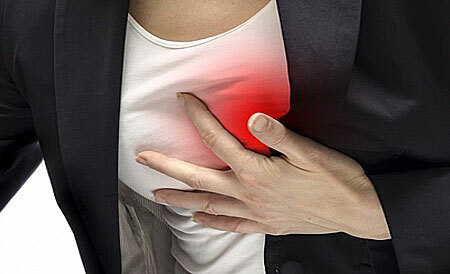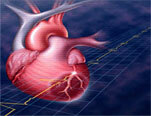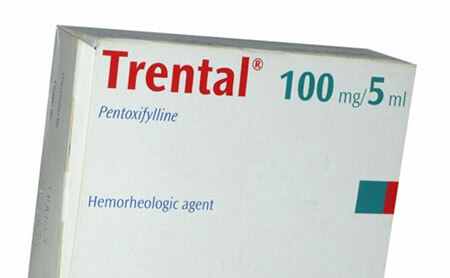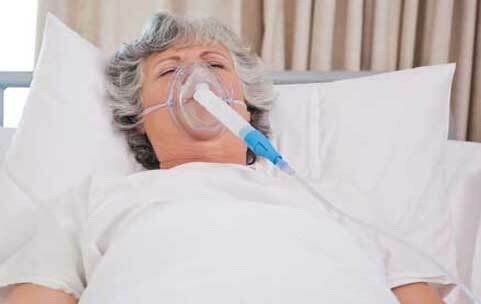Cardiac asthma is an emergency that occurs when the ability of the left ventricle of the heart to reduce - acute left ventricular failure.
Normally, the blood from the vessels of the small circle of the blood circulation( pulmonary veins) enters the left ventricle, and then, as a result of the reduction of its walls, it is pushed into the aorta and enters the large circle of blood circulation.
If the contractility of the left ventricular myocardium decreases, it becomes unable to pump blood through a further chain. This leads to stagnation in a small circle - the vessels that pass through the lungs. As a result, they increase the pressure exerted by blood on the vascular wall, which leads to an increase in permeability.
Therefore, the liquid part of the blood "is squeezed through the wall of the vessel" and turns into the lung tissue( in the interstitial space).The accumulation of fluid inside the lungs is accompanied by characteristic symptoms and leads to a violation of breathing, as a consequence - oxygen starvation of the body. And in the absence of assistance, to complete "flooding" - pulmonary edema, which is dangerous fatal.
Thus, with cardiac asthma there are 2 important pathogenetic aspects. The first is increased vascular pressure in a small circle, the second - ischemia( oxygen starvation) of internal organs with the development of their insufficiency.
Contents
- 1 Causes of cardiac asthma
- 2 Symptoms of cardiac asthma
- 3 Diagnosis of the disease
- 4 Treatment of cardiac asthma
- 4.1 Forecast
- 5 Prevention of cardiac asthma
Causes of cardiac asthma

Causes leading to the development of cardiac asthma are very diverse and multifaceted. Conventionally, they can be divided into four groups:
- Immediate defeat of myocardiocytes - smooth muscle cells that perform a contractile function in the heart;
- Increased load on the left ventricle, which eventually leads to its decompensation;
- "Wrong" rhythm of heart contraction, which reduces the quality of its work as a "pump" of the body;
- Increased blood flow to a weakened heart.
Thus, the ability of the heart muscle to contract decreases:
1. With a decrease in the number of functioning muscle cells - myocardiocytes:
- Acute myocardial infarction of the left ventricle is the most common cause of cardiac asthma;
- Acute myocarditis is an inflammation of the heart muscle, usually developing after a number of infectious diseases( most often after the flu);
- Atherosclerotic cardiosclerosis is the deposition of plaques from "harmful" cholesterol on the heart-feeding vessels( coronary arteries).
2. With increasing pressure on the left ventricle, marked with:
- , the occurrence of strong resistance from the vessels to which blood is pumped, for example, in hypertension;
- stagnation of blood inside the left ventricle - heart defects( mitral stenosis, aortic insufficiency), trauma of interventricular septum, ventricular tumor, large intraventricular thrombus;
- increased blood flow from the pulmonary vessels, due to edema in pneumonia, especially in combination with a weak heart in ischemic myocardial disease;
- increase in blood volume in the body, for example, fluid retention in kidney diseases, as well as large amounts of intravenous fluids( therefore, in the conduct of detoxification therapy it is important to calculate its adequate volume, for fear of hyperhydration).
3. The most frequent heart rhythm disturbances, cardiac asthma, is a decrease or increase in heart rate( brady- and tachyarrhythmias of both ventricular and atrial origin).
4. This group of causal factors is combined, i.e.on chronic heart patients with increasing physical and emotional load, being in a horizontal position.
This can increase blood flow to the heart and trigger cardiac asthma with heart failure and a weak myocardium.
Symptoms of cardiac asthma

Symptoms of cardiac asthma may appear several days before the onset of an attack, in the form of a small cough and shortness of breath. These are nonspecific predictors, which should be given attention in the presence of causative diseases. But to develop an acute condition, the action of provoking factors is necessary.
These include:
- physical load;
- nervous tension;
- body position change.
The onset of cardiac asthma begins sharply, more often at night, in a supine position. The first symptoms are a feeling of lack of air and shortness of breath. The patient wakes up in a panic, feels the fear of death, is frightened and excited.
He suffers suffocation, to overcome which he tries to sit - it is easier to inhale and exhale due to the work of additional muscles of the chest. In addition, in the prone position, there is a significant increase in dyspnea. The observed forced position in cardiac asthma is called orthopnea. The duration of the respiratory phases also changes. So, the breath becomes difficult, and the exhalation lengthens.
A dry cough appears, then it becomes wet. Cough does not bring relief to the patient. It appears reflexively to irritate the air of swollen bronchial mucosa, rather than to the presence of pathogenic agents.
After a while sputum gets a foamy character, it becomes pale pink due to the ingress of blood cells from the injured and blood vessels into it( microtrauma is the result of increased coughing as a result of pressure).
In severe cases, foamy sputum is also released through the nose.
 Specific symptoms of an attack of cardiac asthma - the appearance of wheezing, which is audible at a distance, suggests an aggravation of the situation and the beginning of pulmonary edema. At this time, the patient needs emergency medical attention, becauseprogressive acute hypoxia.
Specific symptoms of an attack of cardiac asthma - the appearance of wheezing, which is audible at a distance, suggests an aggravation of the situation and the beginning of pulmonary edema. At this time, the patient needs emergency medical attention, becauseprogressive acute hypoxia.
Patient's pale skin, fingers, ears and nose with cyanotic shade( cyanotic), a large amount of cold sweat( a sign of dysfunction of the autonomic nervous system).
Arterial pressure may be normal, elevated or decreased - this depends on the cause of the attack. At the same time, its level is important to consider when conducting therapy, becausesome drugs used to stop the attack, increase blood pressure. At this time, a frequent pulse is determined, up to 150 beats per minute.
The pulse rate is a compensatory reaction aimed at decreasing the degree of ischemia of the organs. It develops as a result of a decrease in the partial pressure of oxygen in the blood and subsequent stimulation on this background of the medulla oblongata. In it is the center of regulation of cardiac activity.
Diagnosis of the disease
Diagnosis is based on an objective examination of the patient. The basic criteria are the identification of a characteristic posture( orthopnea), dyspnea, pallor of the skin, the release of foam sputum.
It is very important for patients with cardiac asthma and their relatives to know how to determine the presence of dyspnea. Let us describe this technique. A person's hand is placed on the person's stomach and it is detected 60 seconds. During this time interval, the number of perfect respiratory movements is calculated( 1 movement is inhalation + exhalation).The norm is 16 per minute. About dyspnea is said when their number is increased to 20 or more times.
The described technique helps to distinguish and simulate patients who are artificially breathing faster. To identify such people, they should not tell what purpose the hand is placed on the stomach, and they will not know that the counting of the breath is being made.
The appearance of shortness of breath and difficulty breathing makes it necessary to conduct differential diagnosis of cardiac and bronchial asthma. The bronchial asthma will be indicated by the connection with allergies, the predominant difficulty of exhalation( the expiratory nature of dyspnea), the more pronounced dry wheezing when listening to the lungs( auscultation).
During an attack of bronchial obstruction, a person rests his hands on the back of the bed, handrails, so that as much as possible of the auxiliary muscles can be used to facilitate exhalation.
Usually, with cardiac asthma, a scant at first auscultatory picture is combined with a severe general condition. As the development of circulatory disturbances, wet rales appear, first in the lower parts, and then over the whole surface of the lungs. Chrypses in the formation of pulmonary edema become large bubbles and audible at a distance, so the surrounding people must hear them.
If an ambulance has not been called earlier, then at this stage you should immediately call the emergency number.
When listening to the heart, additional noises, complex rhythm disturbances( gallop rhythm) are revealed. Confirm the attack data ECG, dopplerography, radiography, ultrasound of the heart. These studies are already carried out in hospital after hospitalization of the patient.
Treatment of cardiac asthma

Acute heart failure requires immediate response in the face of a serious threat to human life. If you suspect that symptoms characteristic of cardiac asthma occur, treatment should be started on site.
The patient is untransportable before being withdrawn from the attack. After the improvement of the condition, hospitalization and additional therapeutic correction are mandatory.
Prior to the arrival of physicians, the following medical interventions can and should be done that will help reduce the burden on the heart:
- comfortably seat the patient, legs should be dropped;
- put your feet in hot water to dilate blood vessels and hold blood in the vessels of the lower limbs;
- apply tourniquets to the top of the thighs, over the clothes. This measure also will hold the blood in the lower limbs and reduce the flow of blood to the heart. But the duration of application of the bundles should not exceed 20 minutes, i.e.before an ambulance arrives;
- in the extreme case, if medical assistance is not available, you need to make a bleeding from the ulnar vein in the amount of 300-500 ml, with aseptic compliance, and give 1-2 tablets nitroglycerin under the tongue, and with elevated blood pressure add 1 tablet of Corinfar( nifedipine, which extendsvessels) inside without chewing. Bleeding is a measure of the past, so in modern conditions the hospital is not produced. It is resorted to only in conditions of impossibility of rendering qualified assistance, i.e. as a measure of despair .
The medical effect is to eliminate the cause that caused cardiac asthma. The treatment begins to be carried out by the doctors of the ambulance, and then continues with the attending physician in the hospital.

Emergency care for cardiac asthma:
- Elevated head position in prone position, or the patient can be seated, especially with pulmonary edema. If a person has low blood pressure, these actions are not performed to prevent critical brain ischemia;
- Inhalation of oxygen with alcohol vapors to eliminate foaming, through a mask or nasal catheter( ethyl alcohol is an officially recognized defoamer);
- Nitroglycerin is used under the tongue, to dilate the coronary vessels and relieve the load from the heart( intravenously administered with myocardial infarction, in other cases - under the tongue);
- The universal agent is furosemide - it expands the veins and, as a result, provides rapid discharge of the myocardium, which is then intensified by a diuretic action;
- At high pressure, corinfar( nifedipine) is used in tablets inside;
- With strong psychomotor agitation, pronounced dyspnea, it is mandatory to use morphine, which also provides effective anesthesia. This drug acts on the center of breathing, reducing the pathological frequency of respiratory movements, which can not compensate for developing ischemia, but only harms the body;
- If heart rhythm is abnormal, antiarrhythmic drugs are used;
- With improvement in hemodynamics, but with signs of pulmonary edema remaining, hormones( prednisolone) are used. They reduce the permeability of the vascular wall and prevent the release of plasma into the interstitium;
- If develops poorly treatable pulmonary edema - enter heparin in order to correct microcirculation and prevent thrombosis;
- When asthma is combined with cardiogenic shock and pressure reduction, substances that have pressor action: dopamine, norepinephrine( increase the pressure due to direct action on the vessels) are injected intravenously.
Forecast
Like any emergency, cardiac asthma threatens the patient's life. A favorable outcome depends on early detection and rapid initiation of treatment activities, as well as on the severity of the cause that caused the attack.
Without treatment, cardiac asthma leads to pulmonary edema-a condition leading to the patient's death. The characteristic symptoms preceding this state are described above.
Prevention of cardiac asthma

Measures to prevent cardiac asthma are aimed at the adequate treatment of initial diseases that trigger the development of an attack. All patients with cardiac pathologies, increased blood pressure, weakened heart muscle in ischemic disease, it is recommended to avoid conditions that lead to increased stress on the heart:
- physical and emotional overstrain;
- supercooling;
- diseases of ARVI and pneumonia( treatment should begin immediately - with the slightest increase in temperature).
The heart burden can be reduced by monitoring the amount of fluid consumed, as well as the salt that helps delay water in the tissues. The volume of liquid per day - no more than 2 liters, taking into account water and liquid food.
Previously, salt was recommended to be limited to 3-5 grams, taking into account that it is abundant in some finished products( for example, in black bread).At present, dosing should be abandoned altogether. The physiological norm of sodium and chlorine( the constituent chemical elements of table salt) is found in vegetables and fruits.
It is recommended to sleep with an elevation of the head( this measure goes away when adequate maintenance therapy is selected).Regularly perform blood pressure measurements. Improve circulation of blood on foot, moderate exercise in the form of walking, exercising on an exercise bike and swimming.



